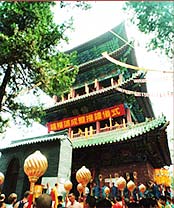| Legole.Com Discover china. Explore the beauty and wonder of the land, people, and culture of China. |
 |
|
|
 |
 Founded in AD 496 during the Northern Wei dynasty, the Shaolin Temple was built in honor of an Indian monk called Bodhidharma (known to the Chinese as Da Mo), founder of the Mahayana sect of Buddhism or more popularly known as Chinese Chan (or Zen) Buddhism. This temple is therefore regarded as the birthplace of Chinese Buddhism. Founded in AD 496 during the Northern Wei dynasty, the Shaolin Temple was built in honor of an Indian monk called Bodhidharma (known to the Chinese as Da Mo), founder of the Mahayana sect of Buddhism or more popularly known as Chinese Chan (or Zen) Buddhism. This temple is therefore regarded as the birthplace of Chinese Buddhism.
The temple, which bore witness to the rise and fall of several dynasties, is also famous for its Martial Arts (Kung Fu). Shaolin Kung Fu is the product of the synthesis of other martial arts principles into a distinctive martial art style. An ancient Shaolin Master once said: "Study Shaolin style in great depth, then study for wisdom and train the body." This quote embodies the physical and mental strength and discipline required in the study of martial arts. In recent years, renewed interest in Kung Fu has led visitors, western & otherwise, to the steps of the temple where schooled martial arts started.
Devajara Hall (Hall of the Heavenly Kings)
Upon entering the mountain gate of the Shaolin Temple, the first hall one encounters is characterized by double eaves flanked behind by a Bell Tower (this tower holds a great bronze bell) and a Drum Tower (this tower holds an artistic drum). The hall gates are guarded by two colored clay figures of Vajras. Inside the hall are statues of the four Heavenly Kings, each standing divinely while holding his distinctive weapon.
Mahavira Hall (Daxiongbaodian)
This is the main hall of the temple. The original was built in the Jin Dynasty but destroyed in 1928. The present structure was restored from the original in 1986. Enshrined in the middle of the hall are the statues of the Trinity Buddha - Sakyamuni, Amitabha (Emitofo) and Bhaisajyaguru (Yaoshifo, God of Medicine). Flanking the Trinity on both sides are eighteen Arhats.
An impressive statue of Kwan-yin (Goddess of Mercy) and a magnificent bronze bell hanging over the Buddha statue can also be found in this hall.
Sutra-Keeping Pavilion
This pavilion was where Buddhist dignitaries lectured. A total of 5480 Buddhist sutras and rubbings are kept in the pavilion.
Hall of Abbot (Fangzhang Hall)
This small hall is the rest place for the abbots. Fangzhan literally means a small place, therefore the name Fangzhan Hall. In 1750, Qing Emperor Qianlong lived here when he visited the Shaolin Temple. From thence, the hall was also known as Long Ting (Hall of the Dragon) because of the Chinese belief that the emperor is the son of the dragon.
Pagoda Forest
Lying to the west of the temple, the Pagoda Forest is a must see for each visitor. The forest features 243 stupas of different architectural styles. It was said that the first stupa was a mound in India that held the body of the Buddha Sakyamuni. Over the centuries, the form of the stupa (or dagoba) became more stylized and eventually evolved (in Chinese Chan Buddhism) to the form seen in the Pagoda Forest. The first stupa at this site was built in 791 AD and the last is dated back to 1803 AD. The construction of the dagobas spanned the Tang, Song, Jin, Yuan, Ming and Qing dynasties. The sizes of these dagobas range from seven stories (14.6 meters) to just a meter in height. All are built in either stone or brick. The exquisite stone and brick carvings are of great value in the study of Chinese carving.
Admission Fee: 50
Opening Hours: 08:10 to 17:30
Recommended Time for a Visit: Two Hours |
 |
|
|
 |
|
